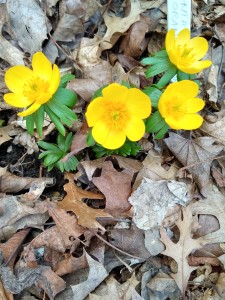 ‘Orange Glow’ is up and glowing, even though “up” is a relative term for a plant that is only a few inches tall. Though it has the same name as a popular cleaning product, ‘Orange Glow’ is in fact a winter aconite, a type of buttercup, belonging to the same Ranunculaceae family as the more common yellow buttercups of summer.
‘Orange Glow’ is up and glowing, even though “up” is a relative term for a plant that is only a few inches tall. Though it has the same name as a popular cleaning product, ‘Orange Glow’ is in fact a winter aconite, a type of buttercup, belonging to the same Ranunculaceae family as the more common yellow buttercups of summer.
Known to botanists as part of Eranthis hyemalis Cilicus Group, ‘Orange Glow’ is actually golden orange in color. In bud, you might confuse it with a snow crocus, but when it spreads its sunny petals, the buttercup family connection reveals itself.
Winter aconites have lovely flowers, but the narrow green leaves are also beautiful, forming a flattering ruff around the blooms. The difference between Cilicus Group plants, like ‘Orange Glow’, and ordinary Eranthis hyemalis varieties is larger flower size and more delicate foliage.
My little patch of ‘Orange Glow’, now five years old, lives under one of my ever-increasing ‘Nikko Blue’ hydrangeas. The hydrangeas look awful right now and still retain most of last year’s flowerheads. I have to do something about that very soon, and maybe the enticing brightness of those orangy buttercups will help move me and my clippers towards the shrubs.
Fourteen years ago, English plantsman Noel Kingsbury referred to ‘Orange Glow’ as “rare” in an article for the Telegraph newspaper. The fact that I have five little specimens of this rarity in my garden makes me feel rather rare and special myself. I received mine from snowdrop guru Hitch Lyman about five years ago. I don’t believe he has sufficient stocks to sell it since. European catalog vendors sometimes carry this and other cilicus varieties, like ‘Guinea Gold’, which has yellow-gold flowers and bronzy foliage, and ‘Flore Pleno’, which boasts double yellow buttercups.
American vendors seem to stick to the more common yellow-flowered types. All are beautiful, but I think that, true to its name, mine glows just a bit brighter.
While ordinary winter aconite is native to Europe, from France to Bulgaria, the cilicus types, like ‘Orange Glow’, hale from farther south, growing naturally in Turkey, Kurdistan, Iran and Afghanistan. It is unclear when cilicus aconites arrived in England, but the more common Eranthis hyemalis were first mentioned by the celebrated English herbalist John Gerard in his Catalogue, published in 1596, when the first Queen Elizabeth was still on the throne. At least one eranthis plant list mentions that ‘Orange Glow’ was first discovered in a Copenhagen, Denmark botanical garden. It was probably a random seedling of another cilicus plant Fortunately, even my “rare” specimens are easy to grow. Some references say they do best in slightly alkaline soil, but mine thrive in the same acid soil that happily supports rhododendrons and azaleas. Like many spring-flowering plants, winter aconite starts as a small tuberous rhizome. You can plant the dry rhizomes in the fall, and this is how most winter aconite is sold in the U.S. The chances for success increase if you buy or beg a division that has been harvested “in the green”, in spring, just after the flowers have faded. This same lifting technique works well for snowdrops.
Once the winter aconites are safely installed in the garden, give them a bit of water if the weather is dry, to help the roots establish themselves. Eventually the top growth will disappear, just like the remains of the daffodils, tulips and hyacinths. The cloak of invisibility that covers such plants through the summer, fall and winter has earned them the nickname “spring ephemerals”. But never fear, winter aconite will return and increase year after year. My ‘Orange Glow’ patch started with one plant and has grown to five. I think the more common types increase even faster because they set seed very efficiently.
To keep things moist and well insulated, mulch your eranthis, preferably with shredded leaves or other organic material. Mark where you planted the little buttercup relatives so you don’t dig them up inadvertently.
If you want to try winter aconite, find a neighbor or internet connection with an established patch and get a division within the next few weeks. If you can’t find anyone to supply ‘in the green” specimens, buy bulbs next fall. A good source is Brent and Becky’s Bulbs, 7900 Daffodil Lane Gloucester, VA 23061; (877) 661-2852; www.brentandbeckysbulbs.com. Free catalog.
